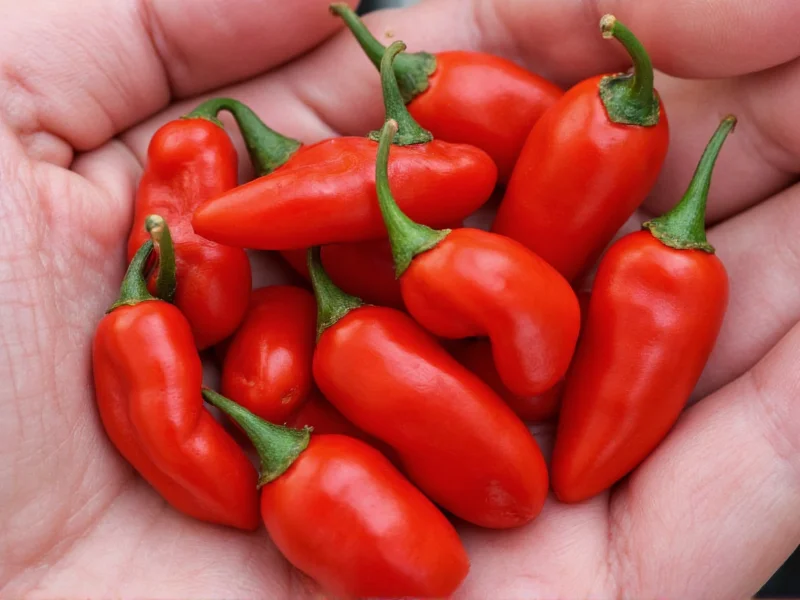When you encounter small red chiles at the market, you're likely looking at one of several potent varieties that pack serious heat in diminutive packages. These peppers serve as essential ingredients across global cuisines, from Thai curries to Mexican salsas and Caribbean jerk seasonings. Understanding their characteristics helps you select the right variety for your culinary creations while managing heat levels effectively.
Common Small Red Chile Varieties
Not all small red chiles are created equal. Each variety brings unique heat levels and flavor notes to dishes. Recognizing these differences prevents recipe disasters and helps you achieve authentic flavors.
| Chile Variety | Scoville Range | Flavor Profile | Common Uses |
|---|---|---|---|
| Bird's Eye (Thai) | 50,000-100,000+ SHU | Grassy, citrusy, intense heat | Thai curries, Vietnamese dipping sauces |
| Pequin | 30,000-60,000 SHU | Smoky, nutty, complex heat | Mexican salsas, adobos, pickled preparations |
| Cayenne (young) | 30,000-50,000 SHU | Sharp, bright, moderately fruity | Cajun seasoning, hot sauces, stir-fries |
| Serrano (red) | 10,000-23,000 SHU | Crisp, fresh, moderately hot | Pico de gallo, guacamole, fresh salsas |
| African Bird's Eye | 100,000-175,000 SHU | Extremely hot, clean burn | African stews, jerk seasoning, hot sauces |
Understanding Heat Levels in Small Red Chiles
When working with small red chile varieties for cooking, understanding their heat progression prevents overwhelming your dishes. Most small red peppers follow this maturation pattern: green (milder, grassy) → yellow/orange (increasing heat) → red (peak heat and flavor complexity). The red stage concentrates capsaicinoids, compounds responsible for heat, making mature red chiles significantly hotter than their younger counterparts.
| Maturation Stage | Time After Flowering | Key Characteristics |
|---|---|---|
| Green | 20-30 days | Mild heat (10-25% of peak), grassy flavor, firm texture |
| Yellow/Orange | 40-50 days | Moderate heat (50-75% of peak), developing sweetness, thinner walls |
| Red | 60-80 days | Peak heat (100%), complex flavor notes, softer texture |
Source: University of California Agriculture and Natural Resources, Chile Pepper Production in California (Publication 8312, p.4)
For home cooks managing small red chile heat in recipes, remember that seeds and white membranes contain the highest capsaicin concentration. Removing these reduces heat substantially while preserving flavor. When substituting small red chiles in international recipes, consider both heat level and flavor profile—Thai bird's eyes won't replicate the smoky notes of pequins in Mexican cuisine.
Contextual Limitations and Special Considerations
While small red chiles enhance many dishes, specific contexts require caution due to physiological and culinary constraints:
- Heat Sensitivity: African Bird's Eye and Thai bird's eyes (100,000+ SHU) should be avoided in dishes for children. The American Academy of Pediatrics notes that capsaicin can cause discomfort in developing digestive systems (HealthyChildren.org).
- Digestive Health: Individuals with IBS or GERD may experience symptom exacerbation from capsaicin. Clinical guidelines from the International Foundation for Gastrointestinal Disorders recommend limiting spicy foods during active flare-ups (IFFGD).
- Culinary Context: In baking or delicate desserts, the intense heat of small red chiles often overwhelms subtle flavors. Reserve them for savory applications unless specifically crafting spicy chocolate dishes where heat is balanced by fat content.
Culinary Applications and Substitutions
Small red chiles shine in applications where intense heat and concentrated flavor matter most. In Southeast Asian cooking, fresh bird's eye chiles provide the signature kick in Thai tom yum soup and Vietnamese pho condiments. Mexican cuisine relies on pequins for complex heat in Oaxacan moles and Yucatecan recados. Caribbean jerk seasoning traditionally uses scotch bonnets, though small red chiles serve as acceptable substitutes when unavailable.
When you can't find specific small red chile varieties, consider these substitution options:
- Replace bird's eye chiles with serranos (use 2:1 ratio)
- Substitute pequins with crushed red pepper flakes (¼ teaspoon flakes = 1 whole pequín)
- Use cayenne powder when fresh chiles aren't available (⅛ teaspoon powder = 1 small fresh chile)
Safe Handling and Storage Practices
Working with small red chiles requires proper handling techniques to avoid skin and eye irritation. Always wear gloves when preparing extremely hot varieties like bird's eyes or African chiles. Never touch your face during preparation, and wash hands thoroughly with soap afterward—even residual oils can cause discomfort hours later.
For optimal storage of fresh small red chiles, keep them unwashed in a paper bag in the refrigerator crisper drawer. This method maintains freshness for 2-3 weeks. For longer preservation, freeze whole chiles on a baking sheet before transferring to airtight containers—they'll last 6-8 months and can be used directly from frozen in cooked dishes. Drying small red chiles creates versatile ingredients for spice blends; string them together and hang in a warm, dry place until brittle.
Recipe Integration Tips
Mastering small red chile usage elevates your cooking significantly. When adding these potent peppers to dishes, always start with less than you think you need—you can increase heat later but cannot remove it once added. For balanced flavor development, sauté whole chiles in oil first to infuse the cooking medium, then remove before serving. When making sauces or salsas, blend chiles with acidic components like lime juice which helps distribute capsaicin more evenly.
Understanding regional small red chile pairings creates authentic dishes: Thai cuisine combines bird's eyes with lemongrass and galangal; Mexican cooking pairs pequins with annatto and cloves; Caribbean recipes marry scotch bonnets with allspice and thyme. These traditional combinations balance heat with complementary flavors for complex results.











 浙公网安备
33010002000092号
浙公网安备
33010002000092号 浙B2-20120091-4
浙B2-20120091-4